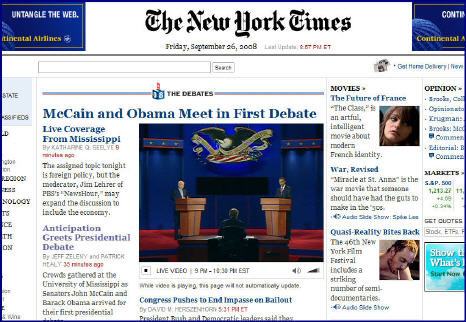-
Paltalk Releases SuperIM URLs for Clientless Video Chatting
Paltalk, the long-time video chat technology provider, is announcing its Paltalk 9.9 beta release today, which includes a feature called SuperIM URLs, which allow users to initiate 1-click, in-browser video conferences without any client download. It's a clever feature that promises to drive higher adoption of personal video conferencing. Paltalk's CEO Jason Katz walked me through a demo yesterday.
SuperIM URLs work like this: say I'm a registered Paltalk user (either free or paid) so I've already downloaded the Paltalk software. I then select a personalized SuperIM address, for example http://www.wrichmond.superim.me. Then I begin publicizing the URL to friends, say through tagging my email signature, Facebook page or business card. People who see the URL simply click on it and, as long as they have a webcam, are instantly connected via video chat with me. Just so I don't have people barging in on me on a bad hair day, I can set privacy controls to always require accept/decline. I can also password-protect the link so I only hear from people I want to. I can also set it so only audio comes on first and I have to manually start the webcam.
I can have up to 10 people in a video chat and display the participants in different mosaics. The most obvious competition for SuperIM URLs is Skype, which I use for video calls. Jason agreed that while Skype does a lot of things really well, Paltalk SuperIM's big differentiator is that it does not require the caller to have downloaded any software to participate.
With SuperIM, the caller simply clicks on the URL provided and is connected. In effect, the conferencing capability is brought to users instead of the other way around. The goal is to make it so easy that anyone's "grandmother can use it" as Jason put it. Even though Paltalk has had its client downloaded some 70 million times, Jason acknowledged that it's a "busy Internet," and it's getting harder and harder to induce people to download any new software.
Another differentiator is Paltalk's multi-party capability, which Skype doesn't offer. This means that a Paltalk user could set up a multi-party video chat around a specific event simply by sending out the SuperIM URL to friends, asking them to click-through at a certain time (think "virtual Super Bowl party").
Going forward, Jason said Paltalk plans to eliminate the step of even having the initial user download the Paltalk software. Paltalk wants to become ubiquitous for mobile users and other portable devices like the iPad. Jason also makes an interesting point that with the spread of $300 Internet-connected netbooks with built-in webcams, personal video conferencing has become more accessible than ever. Paltalk is also aiming for tighter integration with Facebook, so users can initiate video chats to their friends.

I vividly remember that George Jetson's video phone was just about the coolest thing I'd ever seen when I was a kid. SuperIM URLs are yet another indication that the Jetsons' world is upon us.
What do you think? Post a comment now (no sign-in required).
Filckr image via writetechnology
Categories: Technology
-
Presidential Debate Video on NYTimes.com is Classic Broadband Disruption
Here's a classic example of how broadband is causing traditionally distinct worlds to collide: on Friday night the NYTimes.com opened up a dedicated streaming video window on their home page, where the presidential debate played for the full hour and a half. I watched the first half of the debate there, before switching on the TV and watching it on CNN HD. While HD was obviously superior, the NYTimes.com's video was more than adequate (though disappointing there was no full screen option).
Saturday morning and NYTimes.com is offering the video on demand, with an accompanying full written transcript. You can search (try typing "wrong" to see), to get how many times each candidate used that term, and then jump to the points in the video when it was used (alas, it would be great if the Times gave the ability to clip that specific segment and virally distribute it). The Times does offer a "check point" feature, where it fact checks the candidate's assertions. Note that other sites like ABCNews.com and CNN.com have the debate on demand today as well, but not the interactive features that NYTimes.com has.

Stop and consider how significant all of this is - a print publisher using broadband to offer a clear alternative to broadcasters and cable networks in carrying high-quality video. It's a great value proposition just for people without access to TVs at the moment of the live event, but more important, it provides a glimpse of some very interesting additional opportunities for NYTimes.com.
For example, the site could host its own post-debate punditry show, assembling its all-star lineup of daily Times columnists. Dedicated Times readers would no doubt love to see a roundtable with Frank Rich, Tom Friedman, William Kristol, Maureen Dowd and others dissect the candidates' performances, rather than waiting for their thoughts to come in columns over the next several days. Also think about how this type of show would scoop Sunday talk shows like NBC's "Meet the Press" or ABC's "This Week with George S." in bringing serious punditry to political junkies who can't wait.
In fact, the NYTimes.com could even offer viewers the ability to interact with their columnists, building on the wildly popular commenting feature already available with each daily piece in the paper itself. This type of immediacy and interactivity would be very compelling. The site could also offer the live debate video stream with a companion chat area that would enable viewer engagement during the debate itself (see Paltalk for an example of how this could work).
And last but not least, NYTimes.com could offer a single premium sponsorship slot to underwrite its whole debate coverage. Think Mercedes, Four Seasons, Cartier or other upscale brands might be interested?
As I've said many times, broadband blurs previously siloed worlds, bringing more competition to traditional players like broadcast and cable networks. They now need to deliver more to stay competitive. For video entrants like NYTimes, broadband creates enormous new opportunities to both leverage core assets/talent and pioneer new and different ways to create value. Another reminder why broadband is so disruptive for so many.
What do you think? Post a comment.
Categories: Broadcasters, Cable Networks, Newspapers, Politics
Topics: ABC News, CNN, NYTimes.com, Paltalk
-
Paltalk Ramping Up Content Offerings with Paltalk Scene
When I was in NYC earlier this week I caught up with my old buddy Lewis Rothkopf, who's now the VP of Biz Dev at PaltaIk. I got to know Lewis when he was at Lightningcast before it was sold to AOL. Lewis and Joel Smernoff, Paltalk's COO/President gave me a demo of their latest offering Paltalk Scene.

This product allows full video chat and interactivity in private or public rooms, with up to 5K participants per room. It enables what Paltalk calls "social-casting" which means that all chat room participants can watch the same video in the main window and comment/interact around that video. Kind of like a "virtual bar".
I think this kind of engagement around a specific video is very cool and is certainly going to become more popular going forward. Paltalk has already implemented with a bunch of partners including Lifetime for its new Lisa Williams show. And Paltalk is creating a slew of its own "programs" including comedy specials, celebrity "talk shows" and sporting events (wrestling, tennis, etc.).
For Paltalk the goal of these events is to upsell basic members to subscribe to the premium service so they can see video of other members. Down the road there are certainly many other models (PPV, subscriptions, software licensing, etc.). Any user is able to access Paltalk Scene to create their own room.
Paltalk also has an Active X control right now so content partners can embed the video chat window right into their web site, to both retain branding and also offer sponsorship opportunities. Soon there will also be a Flash embed version, which will allow Mac users to enjoy as well.
In short, Paltalk Scene seems like an easy-to-use system for content providers to deepen engagement with their audiences around specific video events creating a totally new user experience.
Categories: Video Sharing
Topics: Paltalk
-
Paltalk Releases Beta of “Screening Rooms”
Paltalk, a company I've written about previously, has released the beta version of a new service it has dubbed "Screening Rooms." Yesterday I got a demo of the service and a briefing with Joel Smernoff, President and COO. After you've registered at Paltalk, you navigate your way (not entirely straightforward, but this is by design for now to suppress demand during beta) to "Finding a Room", and then selecting a "Screening Room." Currently there's a choice of rooms with video from blip.tv, Heavy.com, IFL, Mania TV and Paltalk video.Upon entering a room you're basically in a public IM session with a video window playing. The experience is part of what Paltalk calls "socialcasting", whereby users are able to interact while watching the video. So it sort of emulates watching TV together - collectively chuckling, groaning and critiquing what's on. Basically allowing online engagement to occur around broadband-delivered video.Though it's still early, I think Paltalk's socialcasting theme is very aligned with a concept I've had in mind for some time --- that broadband video is more than just another pathway to bring video into the home, rather it's an entirely new medium to create new consumer experiences. Paltalk's sees it this way too. Their strategy for Screening Rooms is meant to experiment with lots of different types of content. So they're partnering with folks like blip and Heavy, creating their own live events with comedians such as Ray Ellin and possibly developing new shows in hot categories such as travel, cooking, martial arts, etc. Then of course there are the UGC opportunities - uploading your own home movies and inviting friends into a private room for you to narrate.According to Joel, the secret sauce here is really around scalability --- being able to support thousands of participants per room with thousands of rooms running. With 4M active users, Paltalk should have the chops to handle this, but they're taking a go-slow approach for now to make sure there are no big surprises.Categories: Indie Video, Video Sharing
Topics: Paltalk
-
Paltalk's
I had a chance to catch up with an old buddy, Lewis Rothkopf today, who's now VP, Biz Dev at Paltalk. Lewis and I go back to his days at Lightningcast, prior to its sale to AOL. Paltalk is an online video chat community that has about 4M active members. I confessed to Lewis that Paltalk hasn't been on my radar - I'm not the biggest IM'er in the world.
On May 1st, the company is going to be hosting "LateNet with Ray Ellin" in conjunction with DailyComedy.com, a live event from Comix in NYC. If you haven't seen Paltalk in action, this will be a pretty cool opportunity. "Paltalkers", as they're called, will have an opportunity not only to watch the live broadcast alongside others in the chat room, but also to interact with the host/guest in real time. More details here. I'm going to tune in, it seem like a very intriguing way to combine broadband video, social networking and interactivity...
Categories: Aggregators
Topics: Paltalk
Posts for 'Paltalk'
|



